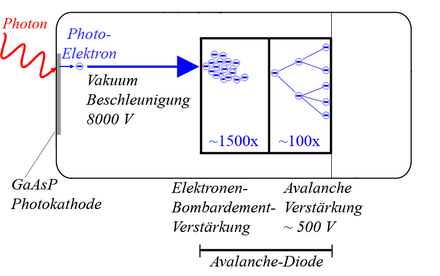Hybrid photodetector
A hybrid photodetector (engl. Hybrid photo detector - HPD , or hybrid photomultiplier tube - HPMT ), partly also shortened as hybrid detector is designated, a device for the detection of very low amounts of light. The name is derived from the fact that the functionality of this detector corresponds to a hybrid of a photomultiplier and an avalanche photodiode . Originally developed for particle physics , it is used in some varieties of fluorescence microscopy , for example in confocal microscopy , fluorescence lifetime microscopy and fluorescence correlation spectroscopy .
Structure and functionality
An incoming photon has to hit the photocathode in order to trigger a reaction. The percentage of incoming photons that actually leads to the release of an electron is called quantum yield (English quantum efficiency refers QE). This first electron is called the photoelectron. Gallium arsenide phosphide (GaAsP) can be used as the material for the photocathode , which, compared to alternative materials, achieves a high quantum yield of up to 45%.
The photoelectron is then strongly accelerated in a vacuum by a high voltage of 8000 volts, for example, in order to strike a semiconductor element, the avalanche diode . This impact is known as electron bombardment. The impact releases numerous electrons in the semiconductor, so that the original photoelectron is multiplied more than a thousand times. The resulting electrons are multiplied fifty to a hundred times in the subsequent avalanche diode, so that, depending on the type of detector and the voltage applied, 50,000 to 150,000 electrons are generated for each photoelectron, enough to be able to detect them with the help of an amplifier .
Advantages and disadvantages compared to photomultipliers
While with photomultipliers the photoelectron is multiplied at the 8 to 12 dynodes in successive steps, with hybrid photodetectors it is only two steps. Due to the high multiplication in the first step, the relative statistical fluctuations (English gain fluctuation ) are much lower here than with photomultipliers, where the first dynode (like the following ones) is only multiplied by a factor of about 3 to 5. Since more or less one electron can be released from dynodes, this leads to a considerable statistical fluctuation in the final number of electrons generated. Due to the low fluctuation, hybrid photodetectors are able to precisely determine the number of photoelectrons initially generated, as long as the maximum recording capacity is not exceeded. In the case of photomultipliers, on the other hand, the generated signal only gives an approximate indication of the number of photoelectrons due to the fluctuations in the multiplication.
The photocathode is typically significantly smaller in hybrid photodetectors with, for example, 8 mm 2 than in photomultipliers with, for example, 50 mm 2 . Since a larger photocathode leads to a larger dark current, this is another advantage of hybrid photodetectors when a large photocathode is not required for technical reasons.
Bright signals can lead to problems with hybrid photodetectors, since the vacuum voltage cannot be downregulated at will as with photomultipliers. Signals that are too bright can also damage hybrid photodetectors, while photomultipliers that are equipped with a multi-alkali photocathode are more difficult to destroy. However, such a photocathode also has a significantly lower quantum yield.
Web links
- What is a hybrid photodetector? (An introduction on the website of the manufacturer Hamamatsu; English).
Individual evidence
- ↑ a b c d e Rolf T. Borlinghaus, Holger Birk Frank Schreiber: Sensors for True Confocal Scanning. In: Science lab.Leica Microsystems , August 23, 2012, accessed December 18, 2014 .
- ^ W. Becker, B. Su, O. Holub, K. Weisshart: FLIM and FCS detection in laser-scanning microscopes: increased efficiency by GaAsP hybrid detectors. In: Microscopy research and technique. Volume 74, number 9, September 2011, ISSN 1097-0029 , pp. 804-811, doi: 10.1002 / jemt.20959 , PMID 23939667 .
- ↑ a b HPD (Hybrid Photo Detector) . In: Hamamatsu Photonics KK (Ed.): PHOTOMULTIPLIER TUBES - Basics and Applications . THIRD EDITION (ed.3a). 2007, Chapter 11, pp. 209–220 ( download the chapter as pdf [accessed December 18, 2014] manual).
